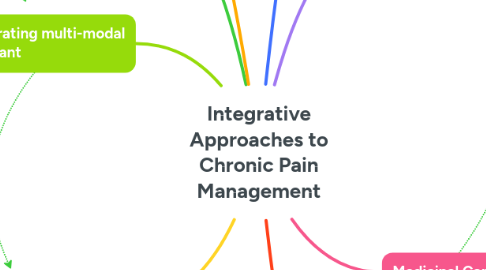
1. Understanding Chronic pain
1.1. Impacts millions worldwide
1.1.1. Impacts activities of daily living such as physical activity, employment, sleep patterns, and relationships
1.2. May lead to mental health challenges like depression and anxiety
1.2.1. Increased risk of substance use disorders
2. Incorporating multi-modal treatmeant
2.1. Can help reduce dependence on high-risk interventions such as opioids
2.1.1. Improve overall health and well-being
3. Interprofessional Collaboration
3.1. Pharmacisits
3.2. Nurse Practitoners
3.3. Physicians
3.4. Intersectoral Collaboration
3.4.1. Achieving optimal chronic pain management requires collaboration among healthcare professionals from different disciplines
3.5. Nurses
3.6. Pain Management Specialists
3.7. Naturopathic practitioner
4. Patient-Centered Care
4.1. Understanding Values and Priorities
4.2. People-Centered Care
4.2.1. address mind, body and spirit
4.3. Holistic Approach
4.4. Collaborative Decision-Making
5. Naturopathic Medicine
5.1. Principles
5.1.1. Holistic Approach Individualized Care
5.2. Modalities
5.2.1. Herbal Remedies Dietary Supplements Massage Therapy Exercise Psychological Interventions
5.3. Challenges
5.3.1. Limited Evidence Regulatory Variations Training and Scope of Practice
6. Medicinal Cannabis
6.1. Components (THC, CBD)
6.2. Indications
6.2.1. Chronic Pain Nausea and Vomiting (chemotherapy-induced) Appetite Loss (AIDS) Muscle Stiffness (MS, spinal cord injury)
6.3. Potential Benefits
6.3.1. Opioid Reduction Quality of Life Improvement Cost-Effectiveness Decrease Inflammation
6.4. Challenges
6.4.1. Regulatory Constraints Physician Hesitancy Education and Awareness
7. Factors Affecting Treatment Seeking Behavior
7.1. Cultural Beliefs
7.2. Socioeconomic Status
7.3. Healthcare Accessibility
7.4. Stigma
7.5. Systemic Challenges
8. Biomedical Approach
8.1. Pharmaceutical Interventions
8.1.1. Analgesics (NSAIDs, opioids,antidepressants)
8.2. Non-Pharmacological Interventions
8.2.1. Physical Therapy Acupuncture Nutrition Exercise Mindfulness-Based Practices
